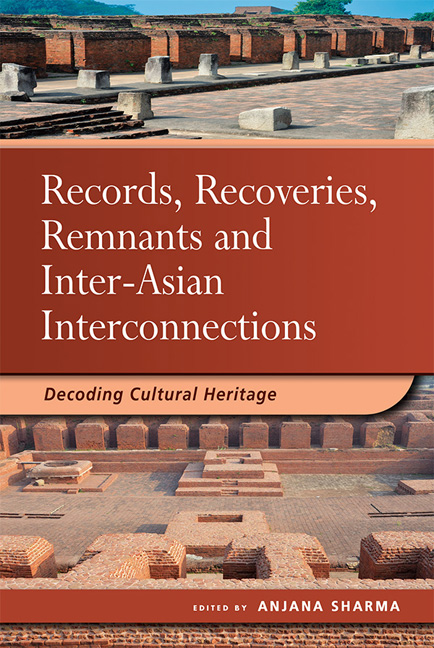Book contents
- Frontmatter
- Dedication
- Contents
- Contributors
- Acknowledgements
- 1 Introduction: Records, Recoveries, Remnants and Inter-Asian Interconnections — Decoding Cultural Heritage
- 2 Negotiating Place and Heritage: Creating Nalanda University
- 3 India, Magadha, Nalanda: Ecology and a Premodern World System
- 4 Collecting the Region: Configuring Bihar in the Space of Museums
- 5 Heritage Preservation in the Gaya Region
- 6 Setting the “Records” Straight: Textual Sources on Nālandā and Their Historical Value
- 7 “Central India Is What Is Called the Middle Kingdom”
- 8 The Object | The Tree: Emissaries of Buddhist Ground
- 9 Tracing Transregional Networks and Connections Across the Indic Manuscript Cultures of Nusantara (AD 1400–1600)
- 10 Seeking a Sufi Heritage in the Deccan
- 11 Archaeological Remains at Nalanda: A Spatial Comparison of Nineteenth Century Observations and the Protected World Heritage Site
- 12 A Heritage Gem Sits in the Heart of a City, Unacknowledged, Incognito: The Case for Recognizing Kolkata Chinatown as a Historic Urban Landscape
- Index
- Miscellaneous Endmatter
9 - Tracing Transregional Networks and Connections Across the Indic Manuscript Cultures of Nusantara (AD 1400–1600)
Published online by Cambridge University Press: 04 July 2018
- Frontmatter
- Dedication
- Contents
- Contributors
- Acknowledgements
- 1 Introduction: Records, Recoveries, Remnants and Inter-Asian Interconnections — Decoding Cultural Heritage
- 2 Negotiating Place and Heritage: Creating Nalanda University
- 3 India, Magadha, Nalanda: Ecology and a Premodern World System
- 4 Collecting the Region: Configuring Bihar in the Space of Museums
- 5 Heritage Preservation in the Gaya Region
- 6 Setting the “Records” Straight: Textual Sources on Nālandā and Their Historical Value
- 7 “Central India Is What Is Called the Middle Kingdom”
- 8 The Object | The Tree: Emissaries of Buddhist Ground
- 9 Tracing Transregional Networks and Connections Across the Indic Manuscript Cultures of Nusantara (AD 1400–1600)
- 10 Seeking a Sufi Heritage in the Deccan
- 11 Archaeological Remains at Nalanda: A Spatial Comparison of Nineteenth Century Observations and the Protected World Heritage Site
- 12 A Heritage Gem Sits in the Heart of a City, Unacknowledged, Incognito: The Case for Recognizing Kolkata Chinatown as a Historic Urban Landscape
- Index
- Miscellaneous Endmatter
Summary
It is truly not easy to write a ‘well integrated’ history of Southeast Asia…. The main difficulty is in fact to transcend the heaviness of regional, colonial and then nationalistic histories which have strongly partitioned off the historical space.
(Lombard 1995, p. 10)INTRODUCTION
Disparate areas of Nusantara experienced a religious and socio-political “paradigm shift” during the period of AD 1400–1600, which here I call “early modern” for the sake of convenience. The Indic-influenced polities of Java and Sumatra, where Hinduism and Buddhism had been prevalent for nearly a thousand years, began to succumb to the advance of Islam and the Islamicate social paradigm. Yet, in spite of — or perhaps thanks to — political instabilities, the disruption (or reconfiguration) of patterns of international trade and diplomacy, and the emergence of new literary genres, religio-ritual paradigms, and social orders, those regions appear to have maintained a vigorous activity of preservation, transformation, and circulation of knowledge based on Indic paradigms.
Victor Lieberman (2009, p. 10) describes a process of cultural integration in Southeast Asia from the fifteenth century onwards, an example of which is what he calls the “demoticisation” of “textually based Indic religions [that] once had been the more or less exclusive preserve of capital-based elites”. (Lieberman here refers to western and central mainland Southeast Asia, and does not look further into the insular region.) Following this lead, in this paper I explore the “parallelisms” that seem to have existed across the mosaic of literary and manuscript cultures of Western Nusantara — i.e., Sumatra, Java, and Bali — in the early modern period. Those locales witnessed the flourishing of vernacular text-manuscript cultures that shared religious ideas, literary conventions, and text-building practices stemming from the heyday of the Sanskrit Cosmopolis and the ensuing Vernacular Millennium (Pollock 1996, 2006). Rather than being separate and delinked peripheries, I suggest that these locales partook, through religious and cultural networks, of a translocal textual tradition of ultimately Indic origin. Although their textual documents were produced in different local contexts characterized by different histories of reception, socio-cultural specificities, and religious contingencies, they appear to have developed in parallel, as it were, from what must once have been a shared Sanskritic tradition.
Here I will approach the literary cultures of early modern Malay and Javano-Balinese spheres by focusing on what Pollock (2007, p. 83) calls the “materiality of manuscript culture”, and elaborate on historical evidence that linked their social and religious contexts. I will first describe the networks of manuscripts and literati in the Javano-Balinese sphere from the late fourteenth to the sixteenth century.
- Type
- Chapter
- Information
- Records, Recoveries, Remnants and Inter-Asian InterconnectionsDecoding Cultural Heritage, pp. 184 - 221Publisher: ISEAS–Yusof Ishak InstitutePrint publication year: 2018



